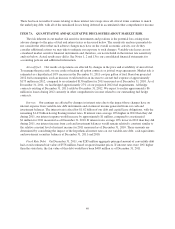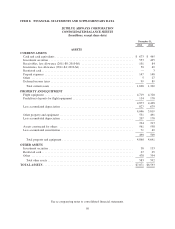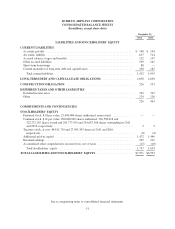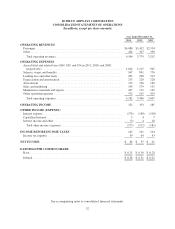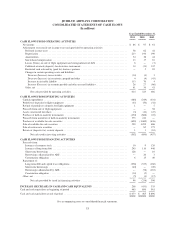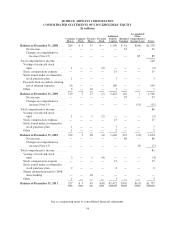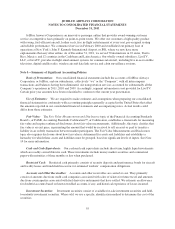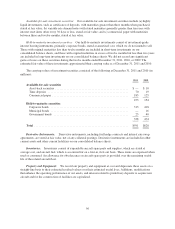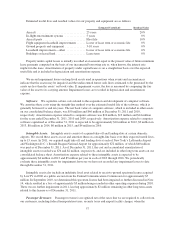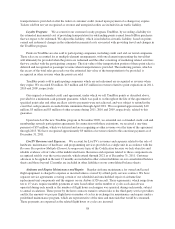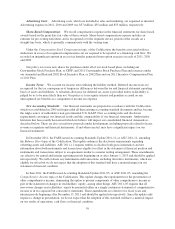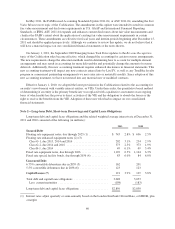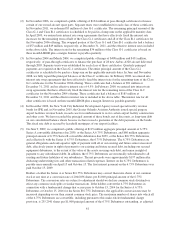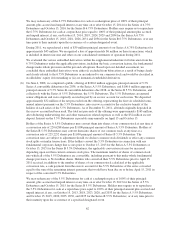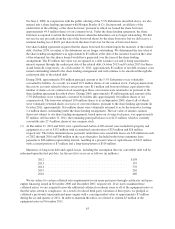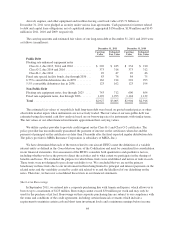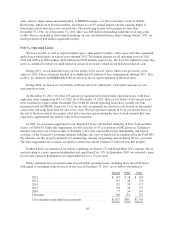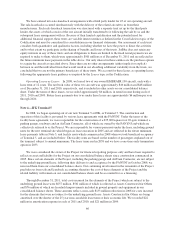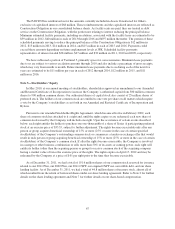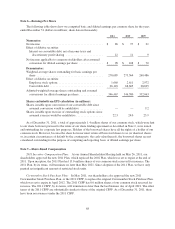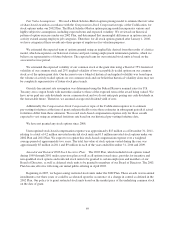JetBlue Airlines 2011 Annual Report Download - page 69
Download and view the complete annual report
Please find page 69 of the 2011 JetBlue Airlines annual report below. You can navigate through the pages in the report by either clicking on the pages listed below, or by using the keyword search tool below to find specific information within the annual report.Advertising Costs: Advertising costs, which are included in sales and marketing, are expensed as incurred.
Advertising expense in 2011, 2010 and 2009 was $57 million, $55 million and $53 million, respectively.
Share-Based Compensation: We record compensation expense in the financial statements for share-based
awards based on the grant date fair value of those awards. Share-based compensation expense includes an
estimate for pre-vesting forfeitures and is recognized over the requisite service periods of the awards on a
straight-line basis, which is generally commensurate with the vesting term.
Under the Compensation-Stock Compensation topic of the Codification, the benefits associated with tax
deductions in excess of recognized compensation cost are required to be reported as a financing cash flow. We
recorded an insignificant amount in excess tax benefits generated from option exercises in each of 2011, 2010
and 2009.
Our policy is to issue new shares for purchases under all of our stock based plans, including our
Crewmember Stock Purchase Plan, or CSPP, and 2011 Crewmember Stock Purchase Plan and issuances under
our Amended and Restated 2002 Stock Incentive Plan, or 2002 Plan and our 2011 Incentive Compensation Plan,
or 2011 Plan.
Income Taxes: We account for income taxes utilizing the liability method. Deferred income taxes are
recognized for the tax consequences of temporary differences between the tax and financial statement reporting
bases of assets and liabilities. A valuation allowance for deferred tax assets is provided unless realizability is
judged by us to be more likely than not. Our policy is to recognize interest and penalties accrued on any
unrecognized tax benefits as a component of income tax expense.
New Accounting Standards: Our financial statements are prepared in accordance with the Codification
which was established in 2009 and superseded all then existing accounting standard documents and has become
the single source of authoritative non-governmental U.S. GAAP. New accounting rules and disclosure
requirements can impact our financial results and the comparability of our financial statements. Authoritative
literature that has recently been issued which we believe will impact our consolidated financial statements is
described below. There are also several new proposals under development, including proposals related to leases,
revenue recognition and financial instruments, if and when enacted, may have a significant impact on our
financial statements.
In December 2011, the FASB issued Accounting Standards Update 2011-11, or ASU 2011-11, amending
the Balance Sheet topic of the Codification. This update enhances the disclosure requirements regarding
offsetting assets and liabilities. ASU 2011-11 requires entities to disclose both gross information and net
information about both instruments and transactions eligible for offset in the statement of financial position and
instruments and transactions subject to an agreement similar to a master netting arrangement. These amendments
are effective for annual and interim reporting periods beginning on or after January 1, 2013 and should be applied
retrospectively. We will evaluate any instruments and transactions, including derivative instruments, which are
eligible for offset but we do not expect that the adoption of this standard will have a material impact on our
statement of financial condition.
In June 2011, the FASB issued Accounting Standards Update 2011-05, or ASU 2011-05, amending the
Comprehensive Income topic of the Codification. This update changes the requirements for the presentation of
other comprehensive income, eliminating the option to present components of other comprehensive income as
part of the statement of changes in stockholders’ equity, among other things. ASU 2011-05 requires that all
non-owner changes in stockholders’ equity be presented either in a single continuous statement of comprehensive
income or in two separate but consecutive statements. These amendments are effective for fiscal years and
interim periods beginning after December 15, 2011 and should be applied retrospectively. Since the update only
requires a change in presentation, we do not expect that the adoption of this standard will have a material impact
on our results of operations, cash flows or financial condition.
59


